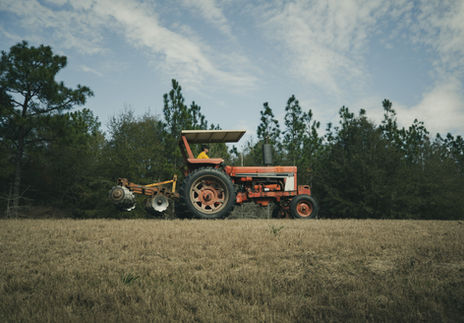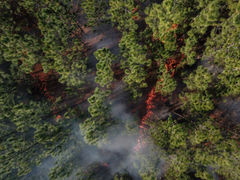
FRIENDLY FIRE
A PHOTO STORY: HOW CO-OPS CAN BRNG BACK PRESCRIBED FIRE TO A COMMUNITY

PHOTO: JUSTIN RECTENWALD
"If one neighbor implements fire as a wildlife management tool, it opens up the dialogue and opportunity for the implementation of prescribed fire across property boundaries."
NATIONAL WILDLIFE COOPERATIVE
A National Wildlife Cooperative photo story (@nationalwildlifecooperative)
Photogrpahy: Russell Addison (@russelladdisonphoto)
BRIEF HISTORY OF THE LONGLEAF PINE
At one point and time, the longleaf pine (Pinus palustris) and its accompanying forest ecosystems covered approximately 60-90 million acres of the United States southeast - an area roughly the size of all acreages in Alabama, Georgia, and South Carolina combined. The longleaf pine excels in nutrient-poor sand hills and red hills of the lower coastal plain, but its historical range extended as far north as northwest Georgia, up the Atlantic coastline into southern Virginia, and as far west as east Texas. The species plays a critical role in maintaining its accompanying ecosystem through increased fire tolerance and specialized fuels (pine needles/wiregrass), that help carry fire across the landscape. The ecology of a longleaf pine reproduction and early growth stages relies heavily on adaptations to frequent fire - giving it an edge to the outer southern pine species (ie. loblolly, shortleaf, and slash pine). Although it maintains these advantages in a frequent fire ecosystem, this species now covers only a fraction of its once vast range - 3.3 million acres (~4% of its historical range, USFS, 2017). With increased land cover conversion from longleaf to agriculture and human developmen, the longleaf pine has been decimated to only a fraction of its once vast range.
In 2010, the U.S. government committed to increasing the acreage of longleaf pine within its historical range through the Natural Resource Conservation Services (NRCS) Longleaf Pine Initiative (LLPI), which "works with producers on private lands within nine states to improve the sustainability and profitability of longleaf pine forest ecosystems" (NRCS 2021). The NRCS provides landowners technical and financial assistance. These practices enable landowners to improve forests, use prescribed burning, and plant young longleaf pine seedlings. Through programs like these, many landowners planted longleaf with the aid of financial assistance, but have not been burning for a myriad of reasons: industrial pine straw production, lack of prescribed fire knowledge, or just a lack of time to burn. This is where our photostory takes place.
CO-OPS CONNECTING FOR FIRE
Within a community, a single landowner can have a profound affect on their neighbors. If one neighbor implements fire as a wildlife management tool, it opens up the dialogue and the opportunity for the implementation of prescribed fire across property boundaries. In much of the southeastern US, smoke filling the skies on a clear winter day is as common as traffic on the New Jersey turnpike. If you drive through the deep south, you are gaurenteed to see a few large plumes of smoke - signifying the continuation of an historical landscape at the hands of an informed and dedicated landowner. So much so, that people will drive by a prescribed fire - next to a busy road - and act as if it is just another day in many rural areas. Prescribed fire is so deeply engrained in these communities that some neighbors will volunteer to help their neighbors begin burning on their property. In the following photo story, the National Wildlife Cooperative followed Brince Coody on his family farm in south Georgia - documenting the process as he successfully implements over 200 acres of prescribed fire in longleaf pine stands that have never been burned before. This property is part of a wildlife cooperative that combined burns over 500 annually.
"In much of the southeastern U.S., smoke filling the skies on a clear winter day is as common as traffic on the New Jersey turnpike." -NWC

About the PHOTOGRAPHER
Russell Addison, Photographer and Hunter / Georgia
Russell Addison was raised in Georgia, growing up to love the great outdoors and documenting wild places and wildlife. Russell currently operates Russell Addison Photography, where he serves clients like Elite Archery, Leupold Optics, Moultrie Products, Southeast Wildlife Innovations, and the National Wildlife Cooperative.
National Wildlife Cooperative retains all rights to the above photos.

























